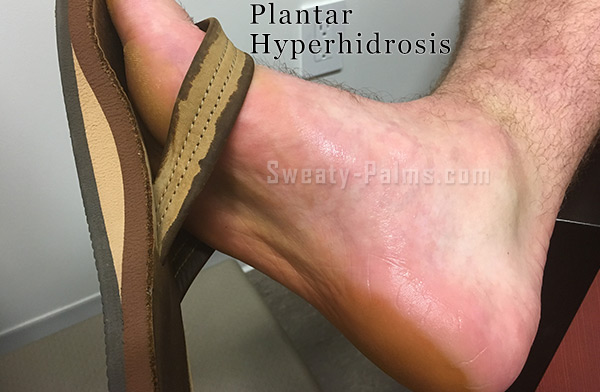Top Dermatology Treatments for Hyperhydrosis of Hands and Feet: What You Required to Know
Top Dermatology Treatments for Hyperhydrosis of Hands and Feet: What You Required to Know
Blog Article
Unveiling the Intricacies of Excessive Sweating: A Comprehensive Overview to Diagnosis and Management
Extreme sweating, clinically known as hyperhidrosis, is a condition that affects a substantial number of people and can have a profound effect on their top quality of life. While sweating is an all-natural physical feature, its overactivity in hyperhidrosis provides an unique set of difficulties that often go past plain discomfort.

Comprehending Hyperhidrosis Causes
Hyperhidrosis creates can be associated to various factors such as genetics, hormone inequalities, and specific medical problems. Genetics play a substantial duty in key focal hyperhidrosis, where individuals acquire the condition from their family members. By identifying the details elements adding to too much sweating, medical care companies can customize therapy strategies to deal with the underlying cause, offering relief and enhancing the top quality of life for people affected by hyperhidrosis.
Acknowledging Hyperhidrosis Symptoms

Furthermore, hyperhidrosis signs and symptoms may materialize in emotional and social distress, as people might feel self-conscious or distressed regarding their sweating, resulting in evasion of social situations (How to stop sweaty hands). Furthermore, repeated episodes of excessive sweating can result in skin maceration, fungal infections, and a general decrease in self-esteem
Diagnostic Process for Hyperhidrosis
Initiating the diagnostic process for extreme sweating involves extensive assessment of the individual's clinical history and checkup. Inquiring concerning the start, duration, and causes of sweating episodes is vital to set apart between primary focal hyperhidrosis and second generalized hyperhidrosis. Case history should also consist of concerns about medicines, medical conditions, and household background of hyperhidrosis.
Throughout the checkup, specific interest is paid to the locations affected by sweating. The health care company might analyze the level of sweating, look for indications of underlying conditions, and examine the influence of sweating on the person's top quality of life. Additionally, certain tests like the gravimetric test, starch-iodine examination, or skin conductance measurements may be carried out to measure the amount of sweat generated.
In addition, in situations where second hyperhidrosis is suspected, additional tests such as blood tests, pee tests, and imaging research studies may be suggested to determine the underlying source of too much sweating. The analysis process aims to precisely identify the type and source of hyperhidrosis to lead suitable administration methods.
Treatment Options for Hyperhidrosis
When resolving excessive sweating, various therapy alternatives are available to reduce symptoms and enhance the person's lifestyle. The therapy method for hyperhidrosis relies on the extent of symptoms and the patient's response to preliminary treatments.
Topical therapies, such as aluminum-based antiperspirants, are typically suggested as the link first line of protection for handling mild instances of hyperhidrosis. These items function by connecting the sweat air ducts, therefore lowering the amount of sweat that reaches the skin's surface. For people with much more serious symptoms, oral drugs like anticholinergics may be suggested to assist reduce sweating. However, these medications can have side impacts more tips here and are not appropriate for every person.

Effective Management Techniques
To successfully handle hyperhidrosis, a customized and extensive therapy strategy tailored to the individual's certain needs and feedback to previous treatments is vital. This plan may incorporate a mix of restorative methods, consisting of way of living alterations, topical treatments, dental medications, botulinum toxin shots, iontophoresis, and in extreme situations, surgical treatments like gland elimination or sympathectomy. Way of living adjustments such as wearing moisture-wicking garments, making use of antiperspirants, and exercising stress-reducing methods can complement medical treatments. Topical antiperspirants having aluminum chloride are typically the first-line therapy, with more powerful formulas available for resistant cases. Oral medications like anticholinergics might be suggested for generalized hyperhidrosis. Botulinum contaminant shots are efficient for focal hyperhidrosis, providing temporary relief by obstructing the launch of acetylcholine. Iontophoresis, entailing using a low electric current to decrease gland task, can be beneficial for both palmoplantar and axillary hyperhidrosis. Surgical choices pop over here are generally reserved for extreme, refractory cases and require careful consideration of advantages and threats. A multidisciplinary technique involving skin specialists, medical care medical professionals, and, if needed, surgeons, can maximize the monitoring of hyperhidrosis.
Verdict
In final thought, hyperhidrosis is a condition identified by excessive sweating, which can substantially influence an individual's high quality of life. With correct medical diagnosis and administration approaches, individuals suffering from hyperhidrosis can locate alleviation and enhance their overall well-being.
Extreme sweating, medically understood as hyperhidrosis, is a problem that impacts a considerable number of individuals and can have an extensive influence on their high quality of life. By determining the details factors contributing to extreme sweating, health care suppliers can tailor therapy plans to deal with the underlying reason, providing relief and boosting the top quality of life for people influenced by hyperhidrosis.
Hyperhidrosis, characterized by excessive sweating past what is required for controling body temperature level, can substantially influence an individual's high quality of life. Making inquiries about the beginning, period, and triggers of sweating episodes is critical to distinguish in between primary focal hyperhidrosis and second generalised hyperhidrosis. How to stop sweaty hands.In conclusion, hyperhidrosis is a problem characterized by too much sweating, which can considerably influence an individual's top quality of life
Report this page